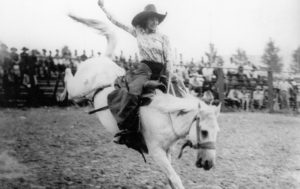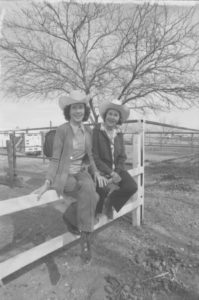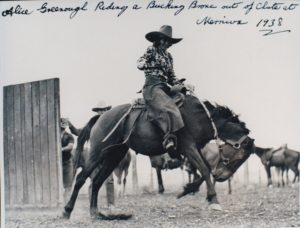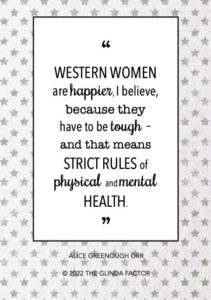
Brilliant Businesswoman
She was a world champion bronco rider until the major rodeo promoters suddenly decided to ban women from riding because it was “too dangerous.” She wasn’t ready to retire, so instead she started and ran her own rodeo, which became one of the most successful in the country. Hop on a horse back to 1941 and meet Alice Greenough Orr…
Her Ruby Shoe Moment
The Power of the Wand
Her Yellow Brick Road
Brains, Heart & Courage
Glinda’s Gallery
Just the Facts
Her Ruby Shoe Moment
Alice Greenough had a decision to make. It was 1941, and the major rodeo promoters had just announced that women would no longer be allowed to enter bronc riding competitions because it was “too dangerous.” This ban included Alice – even though she had won four bronc riding world championships between 1933 and 1940. She had spent the last decade traveling the world competing in front of adoring audiences, and now she faced the sudden end of her career. The choice before her: accept her fate and retire from the rodeo circuit or create an alternative option from scratch.

Alice on a bronc (Carbon County Historical Society & Museum)
Alice thought of Joe Orr, a fellow rodeo competitor, and weighed whether to approach him with her idea. She could hear her dad’s voice telling her to “Take Old Willie with you.” Old Willie was family slang for willpower, which her dad said could turn any situation into an opportunity. So Alice decided this was a moment for Old Willie, took a deep breath, and asked Joe if he would be interested in starting a “rodeo outfit” with her.
Alice made her case to Joe for why she was a good bet. She reminded him that she had been performing in rodeos since she was a teenager – getting her start in a makeshift arena in her Montana hometown. She started as a talented trick rider, but her main love became bronc riding competitions. She rode her first bronc when she was just 17.

Alice (Carbon County Historical Society & Museum)
Alice’s skill at staying on a bucking bronc quickly made her a household name on the rodeo circuit. Alice’s sister and brothers (Margie, Bill, and Turk) were skilled riders too, and the four began billing themselves the “Riding Greenoughs.” They built an enthusiastic fan base in the United States, Europe, and Australia. Alice performed in 47 states several countries. New York in particular was a successful stop – rodeos featuring Alice sold out and often attracted society elite like the Chryslers, Vanderbilts, and various sports and arts celebrities. And when she was in England, she met the King and Queen!
Joe was persuaded by Alice’s expertise and enthusiasm. The two of them began a stable of broncs to be the equine stars. The Greenough-Orr Rodeo opened its doors in 1945, with Alice serving as the executive producer. She negotiated contracts with performers and arenas, ran payroll, and was head accountant, keeping the books by hand. organized the acts and competitions. She added flair and entertainment value with her talent for costumes. She included women’s barrel racing – which no other rodeo did. And of course, she also rode broncs for the crowd in every rodeo presented. She earned a new nickname: She Boss.
The Power of the Wand
The Greenough-Orr Rodeo traveled around the northwest for the next 14 years, until Joe and Alice decided to retire. Alice rode her last bronc at age 57. When Alice was inducted into the Cowgirl Hall of Fame, she summed it up: “the rodeo life was a good life,” She often said she was first inspired by meeting Fanny Sperry Steele, 1912 and 1913 Women’s Bucking Horse Champion of the World, when she was a girl.
Alice’s legacy lives on in Oregon rider Najiah Knight. Najiah was the first girl to ride with the Mini Bull Riders circuit and when she was 13 was the first girl to ride a bull at Madison Square Garden. Her ultimate goal is to be the first woman to compete in the Professional Bull Riders “Unleash the Beast” circuit, where the top bull riders from all over the world compete.
Her Yellow Brick Road
Alice turned her bronc riding hobby into a career when she was 27. She was working in a boarding house near her family’s ranch when she opened up a Billboard Magazine and saw a “Cowgirls Wanted” ad for Jack King’s Wild West Show. Alice and her sister Margie responded to the ad, and Jack invited them to travel to Ohio for an audition. Alice and Margie showed up in homemade costumes made with unique colors, patterns, and fringe. Jack was impressed with the the flair their personal style added to traditional bell bottoms and bolero jackets. But he was even more impressed by their repertoire of tricks and by Alice’s skill on the broncs. He invited them on the spot to travel with the Show – and warned them they would be the only women on the tour other than Jack’s wife!

Alice and her sister Margie in 1976 (Benjie Sanders, Arizona Daily Star)
Alice and Margie quickly became a central part of the Show – riding in team and individual relay races, trick riding exhibitions and bronc competitions. They were paid $14/week base salary plus their winnings from the competitions, where a first place could earn $20-30. Their accommodations weren’t luxurious – they lived in tents near the rodeo grounds at most stops. They traveled relatively light to make it easier to pack up, although they did bring their sewing machine to keep their costume game fresh. Performing in Madison Square Garden in New York was like a vacation because they got to stay in a hotel!
Bronc riding was dangerous, and Alice’s luck finally ran out during a competition in El Paso, Texas. Her foot got caught in her stirrup as she was bucked off a bronc, and her ankle broke in several places. The injury didn’t heal on its own because her bones were so twisted. After nine months in the hospital, doctors said her only option was to amputate her foot and ankle. Alice was debating what to do when a German doctor visiting El Paso heard about her plight. He told her doctors about an experimental surgery in Germany where bad breaks were held together by ivory pegs that helped bones fuse. It worked, and Alice was finally able to return to the Show with a new nickname – “The Girl with the Ivory Ankle.” She did some performing but still needed crutches for walking.
Once her ankle was 100%, Alice wanted to make up for lost time. So when a Spanish promoter asked her to go to Spain and perform in a bull ring, she said yes, even though she had never seen one. She traveled to Mexico City’s Rancho Charros festival to get a little experience riding steers in the bull ring there.

Alice on a bronc in 1938 (Australian Stockman’s Hall of Fame and Outback Heritage Centre)
When she arrived in Spain, she assumed that she would be riding steers, but they told her that she was there to ride the bulls into the arena before a bullfight. Alice rode bulls in most of Spain’s biggest bull rings. She stood out as an American woman alone in Spain. One day a teacher walking with her students turned them away from Alice so they wouldn’t see a woman wearing pants! After the Spanish circuit, Alice went to France to compete and perform there.
Alice returned home from Europe stronger and more confident than ever, winning the Women’s World Bronc Riding Championship in Boston in 1933, 1935, and 1936. American West culture was popular worldwide, and she spent the next few years traveling, competing, and performing in rodeos all over the world.
But then, after the 1940 World Championships – which sent 17 of 22 competitors to the hospital – rodeo promoters decided that bronc riding was too dangerous for women. Alice wasn’t ready to retire, but the verdict was final: no more women riders. She realized that they only way to get hired to perform was to be in the position to hire herself.
Brains, Heart & Courage
Alice’s dad, Ben, ran away from a Brooklyn orphanage when he was 14. He found work on a horse team that pulled boats up and down the river and learned to ride. He decided to move west, working for railroads along the way, arriving in Montana when he was 16. He loved its beauty and decided to stay, making his living as a cowboy and mountain guide. He befriended the Crow Indians in the area and learned their language.
Alice’s mom was from Illinois. Ben met her on his trip west when he stayed at her mom’s boardinghouse. They wrote each other letters for 5 years. When Ben asked her to move to Montana to marry him, her friends and family advised her to say no because it sounded dangerous. But she was in love, so she packed her things and moved west.
 The Greenoughs turned their homestead at Red Lodge into one of the biggest ranches in the areas. All eight kids were expected to help manage herds of cattle, bring wild horses down from the mountains, feed and groom the horses, and clean the stables. Alice, like her siblings, learned to ride early because it made her chores easier. Her parents said that the horses needed exercise whether the kids rode them or walked alongside them!
The Greenoughs turned their homestead at Red Lodge into one of the biggest ranches in the areas. All eight kids were expected to help manage herds of cattle, bring wild horses down from the mountains, feed and groom the horses, and clean the stables. Alice, like her siblings, learned to ride early because it made her chores easier. Her parents said that the horses needed exercise whether the kids rode them or walked alongside them!
Horses were the Greenoughs’ primary mode of transportation. Alice’s parents never got a driver’s license, so Alice and her siblings rode horses to school. In the summers, the kids would ride into the mountains and camp with their dad while the cattle and horses grazed. They were often there for a month at a time, fishing and hunting for food.
Alice got her first job when a neighbor came to the ranch asking if one of the Greenough boys could help drive a 6-8 horse team to plow hay. Her dad responded “hire Alice.” Then when Alice was 14, she took over her dad’s 37 mile postal route out of Billings, delivering mail by horse every day for 2.5 years. She also helped her dad train wild horses so that they would tolerate a rider with a saddle and reins. Once trained, they sold them to farmers and other ranchers.
Alice’s life wasn’t all work and no play. Community celebrations usually involved a rodeo and everyone was invited to participate. If an arena wasn’t available, people parked cars to block off a circle. Alice loved performing and started with trick riding and relay races.
Alice’s dad had always said that anyone could ride a bronc or a steer if they were coordinated and brave – boy or girl. So when she was 17 and hanging out at a local rodeo with some cowboys who dared her to ride a wild grey bronco, she accepted the challenge. Alice rode it for the audience in the grandstand without getting bucked off.
Glinda’s Gallery
Just the Facts
- Alice was born in 1902 in Red Lodge, Montana.
- Alice was briefly married and had two children before getting divorced. Her children stayed in Montana with their dad while she was on the road.
- Alice appeared in two movies in 1938. She quit because it was too much downtime (boring!) and she they kept asking her to dye her brown hair blonde.
- Alice wrote magazine articles about her life and experiences as a cowgirl. One of the most well known was “What a Cowgirl Wants.”
- Alice founded the Carbon County Historical Society & Museum in Red Lodge, Montana in 1959. She donated many of the items and exhibits from the Greenough family.
- Alice has been inducted into the Cowgirl Hall of Fame, the Cowboy Hall of Fame, and the Montana Cowboy Hall of Fame.
- Alice was voted Best Woman Athlete by Birth State – Montana by Sports Illustrated/CNN.
- After Joe and Alice sold the rodeo, he proposed marriage and she said yes, telling him it was a good idea because “I know all your faults and you know mine.”
- After Joe died, Alice stayed in Tuscon with her sister Marge. Many television and move westerns were filmed in Tucson. The sisters drove horse teams and appeared regularly on the television show “Little House on the Prairie”.
- Alice fully retired when she was 80. She died in 1995 at age 93.
Want to Know More?
D’Ambrosio, Brian. Article about Alice Greenough (Distinctly Montana)
Cohen, Betsy. “Missoulian Legacy Project: Greenough was No. 1 in Rodeo’s Golden Age” (The Missoulian July 20, 2008)
Jordan, Teresa. Cowgirls: Women of the American West
Thomas, Heidi. Cowgirl Up: A History of Rodeo Women
